Mount RENAULT ESPACE 2000 J66 / 3.G Technical Note 3426A User Guide
[x] Cancel search | Manufacturer: RENAULT, Model Year: 2000, Model line: ESPACE, Model: RENAULT ESPACE 2000 J66 / 3.GPages: 52, PDF Size: 0.98 MB
Page 23 of 52
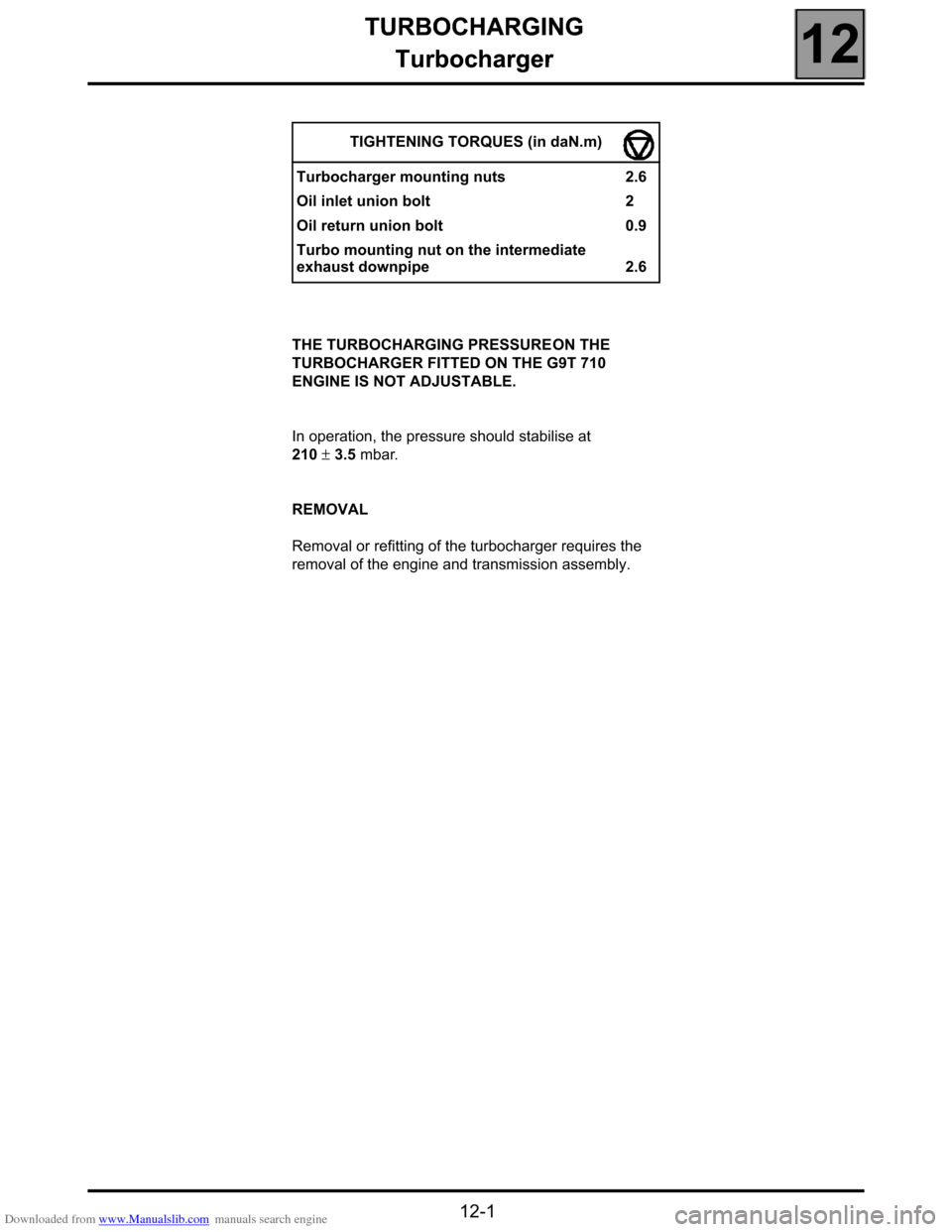
Downloaded from www.Manualslib.com manuals search engine TURBOCHARGING
Turbocharger
12
112TURBOCHARGING
Turbocharger
THE TURBOCHARGING PRESSURE ON THE
TURBOCHARGER FITTED ON THE G9T 710
ENGINE IS NOT ADJUSTABLE.
In operation, the pressure should stabilise at
210 ± 3.5 mbar.
REMOVAL
Removal or refitting of the turbocharger requires the
removal of the engine and transmission assembly.TIGHTENING TORQUES (in daN.m)
Turbocharger mounting nuts 2.6
Oil inlet union bolt 2
Oil return union bolt 0.9
Turbo mounting nut on the intermediate
exhaust downpipe 2.6
12-1
Page 24 of 52
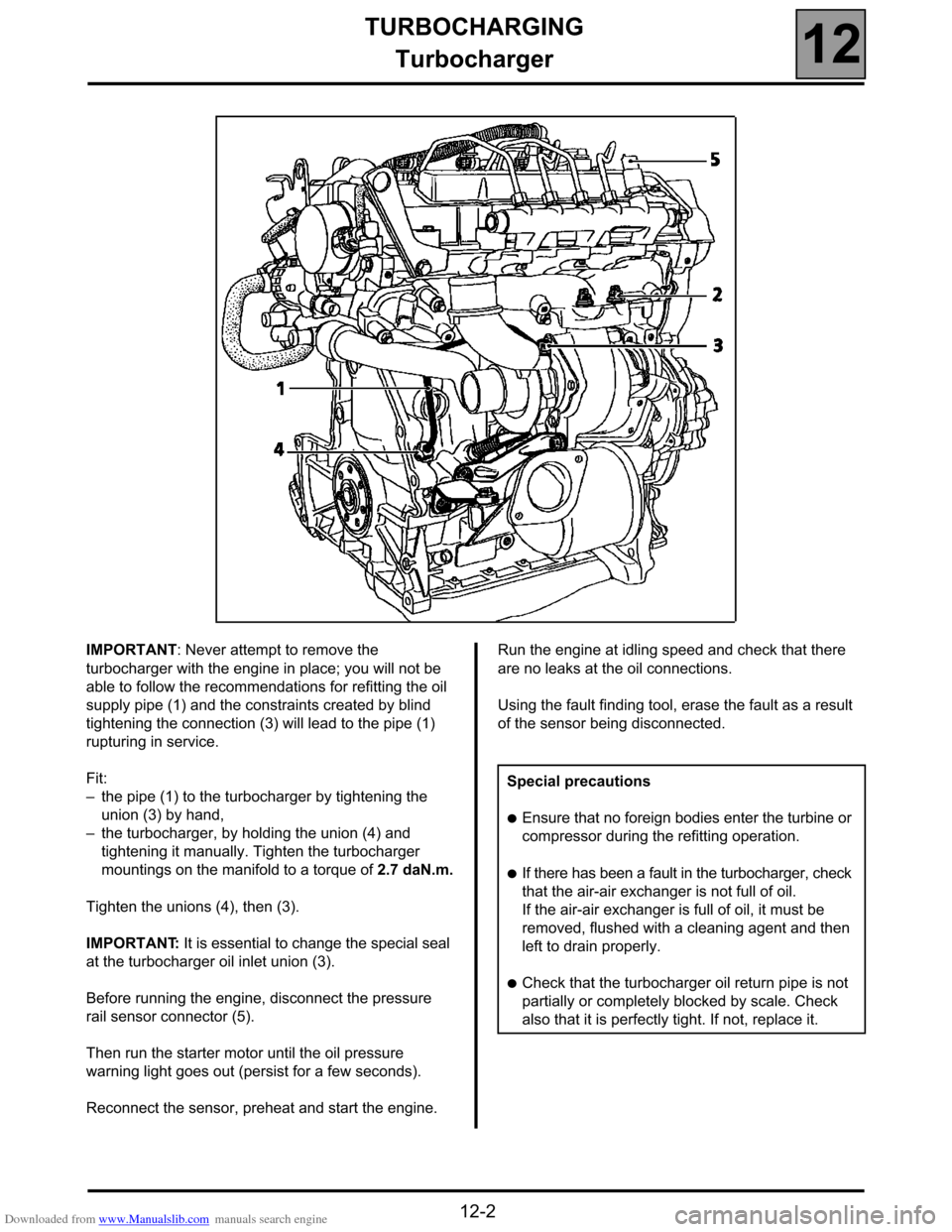
Downloaded from www.Manualslib.com manuals search engine TURBOCHARGING
Turbocharger
12
12-2
IMPORTANT: Never attempt to remove the
turbocharger with the engine in place; you will not be
able to follow the recommendations for refitting the oil
supply pipe (1) and the constraints created by blind
tightening the connection (3) will lead to the pipe (1)
rupturing in service.
Fit:
–the pipe (1) to the turbocharger by tightening the
union (3) by hand,
–the turbocharger, by holding the union (4) and
tightening it manually. Tighten the turbocharger
mountings on the manifold to a torque of 2.7 daN.m.
Tighten the unions (4), then (3).
IMPORTANT: It is essential to change the special seal
at the turbocharger oil inlet union (3).
Before running the engine, disconnect the pressure
rail sensor connector (5).
Then run the starter motor until the oil pressure
warning light goes out (persist for a few seconds).
Reconnect the sensor, preheat and start the engine.Run the engine at idling speed and check that there
are no leaks at the oil connections.
Using the fault finding tool, erase the fault as a result
of the sensor being disconnected.
Special precautions
●Ensure that no foreign bodies enter the turbine or
compressor during the refitting operation.
●If there has been a fault in the turbocharger, check
that the air-air exchanger is not full of oil.
If the air-air exchanger is full of oil, it must be
removed, flushed with a cleaning agent and then
left to drain properly.
●Check that the turbocharger oil return pipe is not
partially or completely blocked by scale. Check
also that it is perfectly tight. If not, replace it.
Page 27 of 52
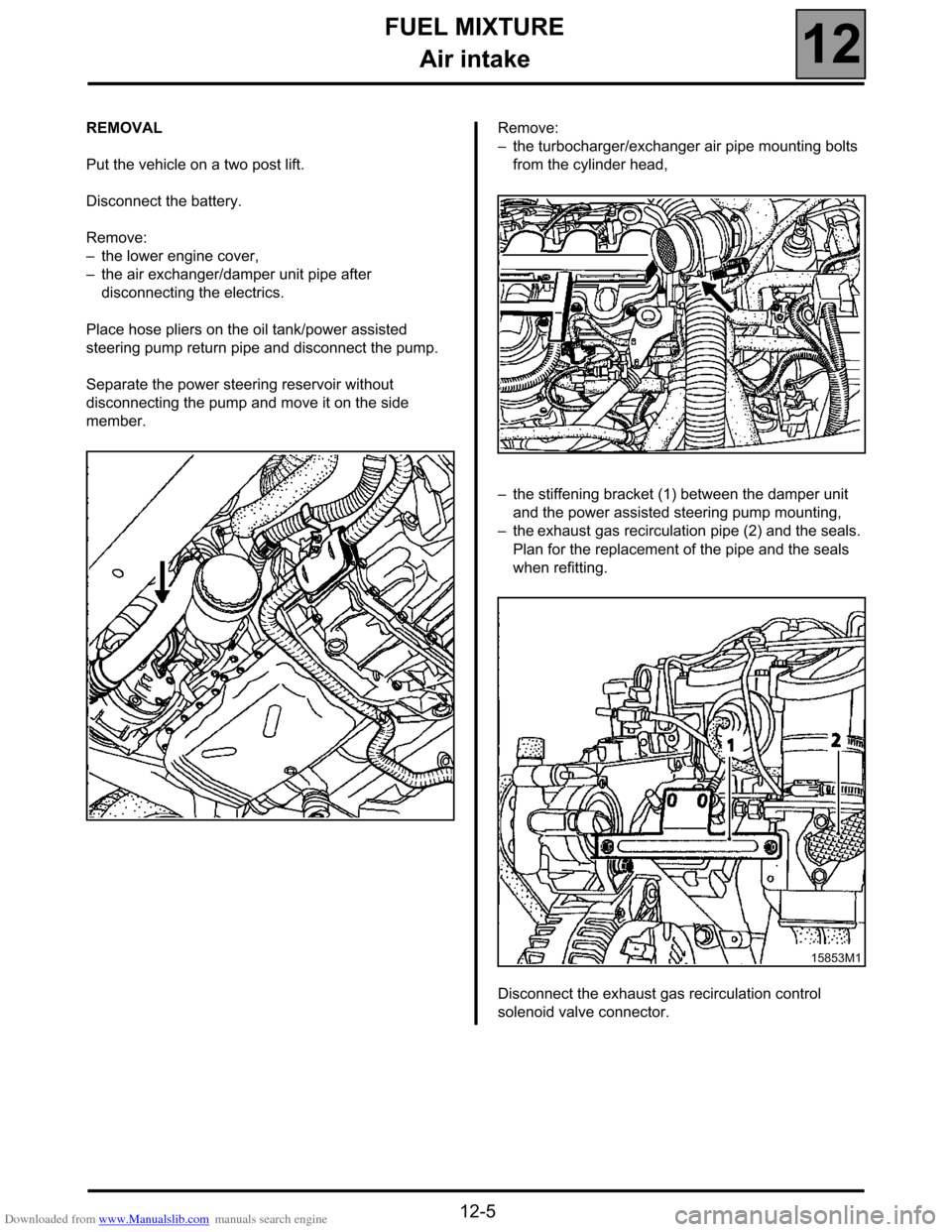
Downloaded from www.Manualslib.com manuals search engine FUEL MIXTURE
Air intake
12
12-5
REMOVAL
Put the vehicle on a two post lift.
Disconnect the battery.
Remove:
–the lower engine cover,
–the air exchanger/damper unit pipe after
disconnecting the electrics.
Place hose pliers on the oil tank/power assisted
steering pump return pipe and disconnect the pump.
Separate the power steering reservoir without
disconnecting the pump and move it on the side
member.Remove:
–the turbocharger/exchanger air pipe mounting bolts
from the cylinder head,
–the stiffening bracket (1) between the damper unit
and the power assisted steering pump mounting,
–the exhaust gas recirculation pipe (2) and the seals.
Plan for the replacement of the pipe and the seals
when refitting.
Disconnect the exhaust gas recirculation control
solenoid valve connector.
15853M1
Page 28 of 52
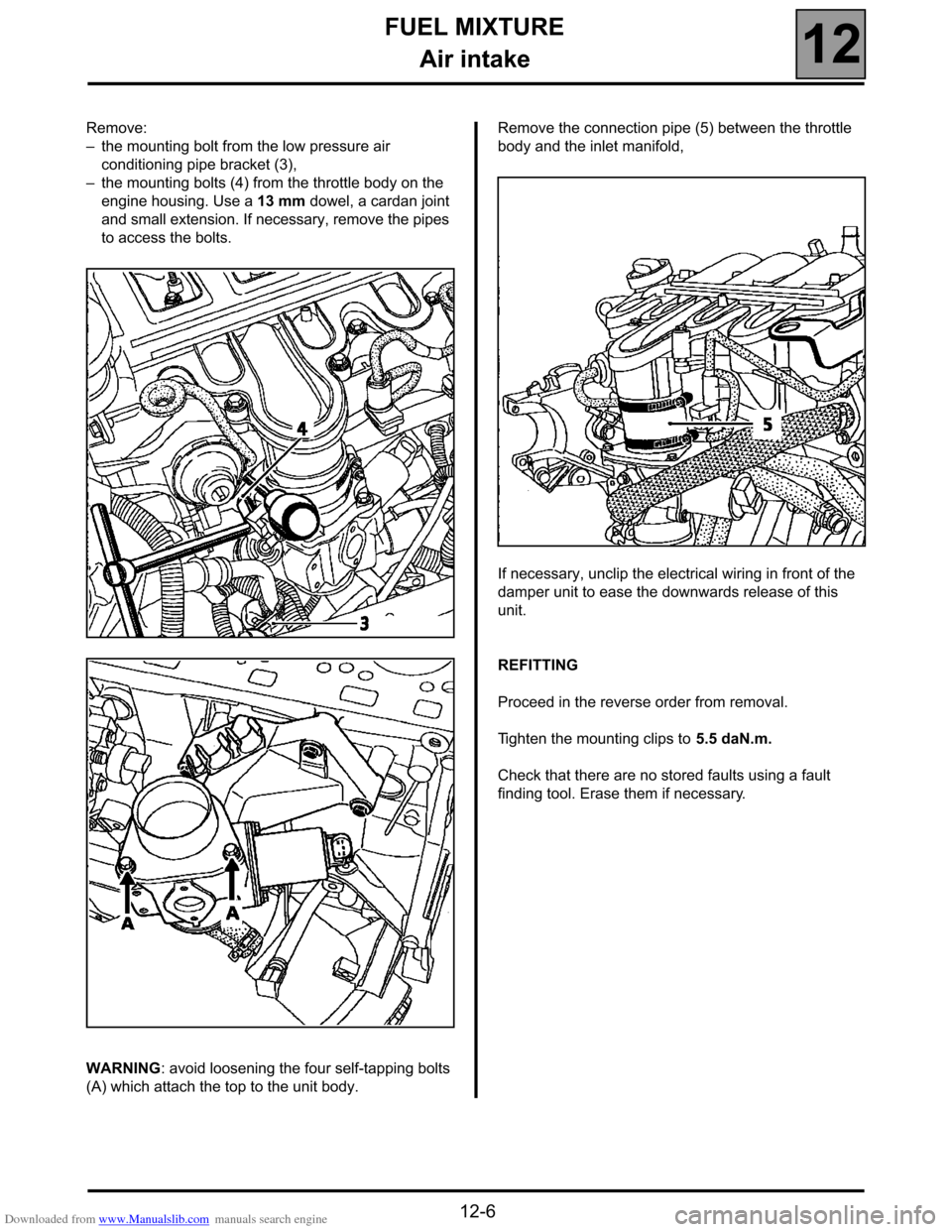
Downloaded from www.Manualslib.com manuals search engine FUEL MIXTURE
Air intake
12
12-6
Remove:
–the mounting bolt from the low pressure air
conditioning pipe bracket (3),
–the mounting bolts (4) from the throttle body on the
engine housing. Use a 13 mm dowel, a cardan joint
and small extension. If necessary, remove the pipes
to access the bolts.
WARNING: avoid loosening the four self-tapping bolts
(A) which attach the top to the unit body.Remove the connection pipe (5) between the throttle
body and the inlet manifold,
If necessary, unclip the electrical wiring in front of the
damper unit to ease the downwards release of this
unit.
REFITTING
Proceed in the reverse order from removal.
Tighten the mounting clips to 5.5 daN.m.
Check that there are no stored faults using a fault
finding tool. Erase them if necessary.
Page 29 of 52
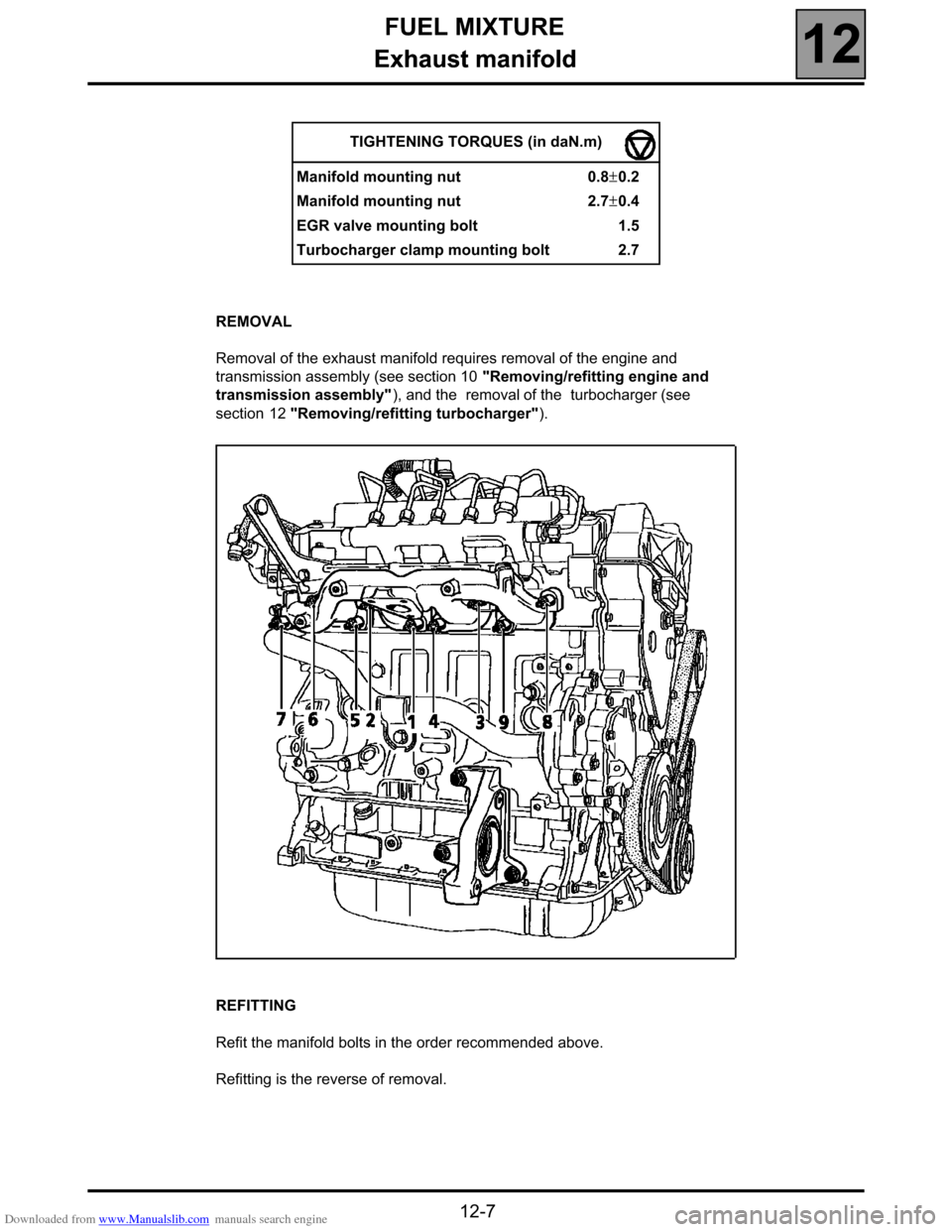
Downloaded from www.Manualslib.com manuals search engine FUEL MIXTURE
Exhaust manifold
12
12-7
Exhaust manifold
REMOVAL
Removal of the exhaust manifold requires removal of the engine and
transmission assembly (see section 10 "Removing/refitting engine and
transmission assembly"), and the removal of the turbocharger (see
section 12 "Removing/refitting turbocharger").
REFITTING
Refit the manifold bolts in the order recommended above.
Refitting is the reverse of removal.TIGHTENING TORQUES (in daN.m)
Manifold mounting nut 0.8±0.2
Manifold mounting nut 2.7±0.4
EGR valve mounting bolt 1.5
Turbocharger clamp mounting bolt 2.7
Page 30 of 52
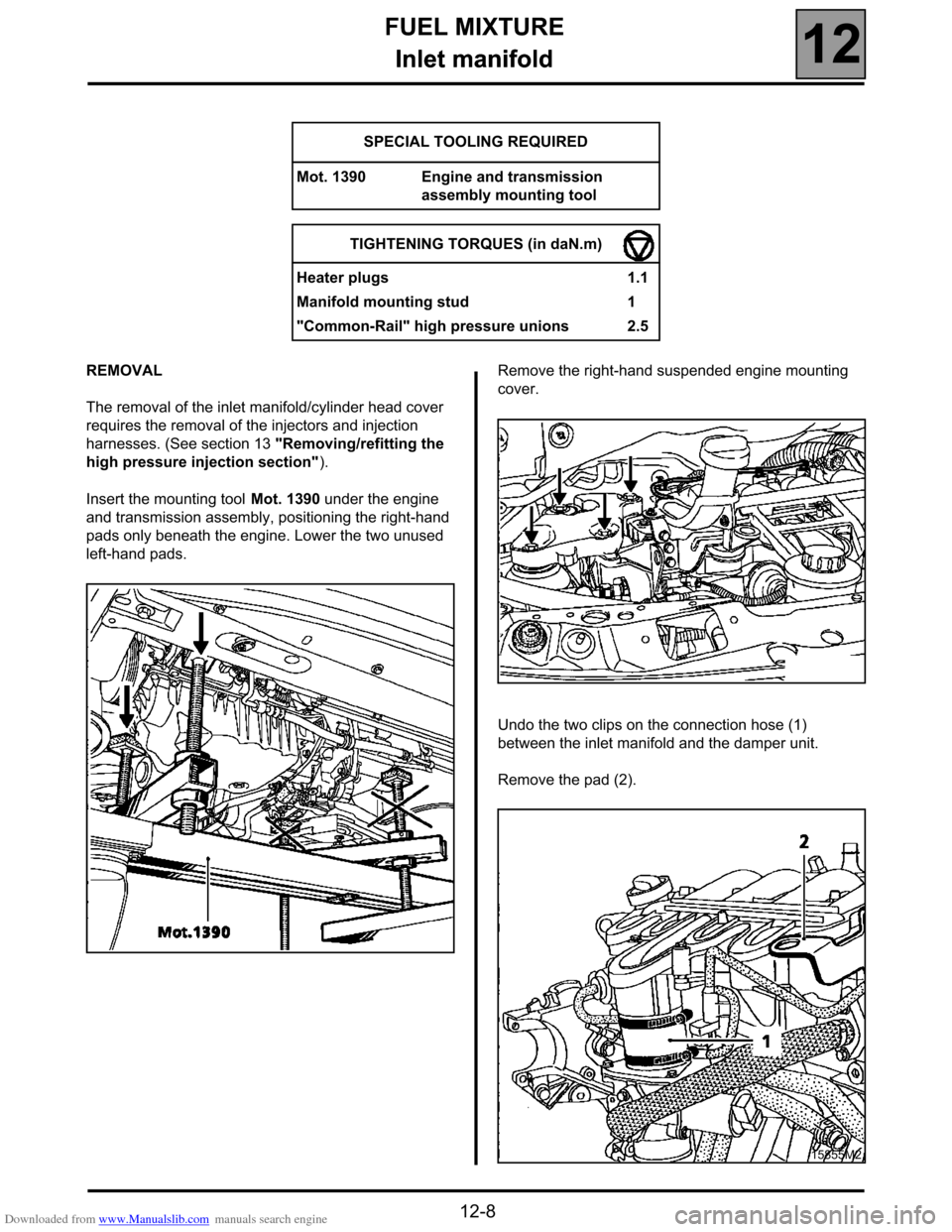
Downloaded from www.Manualslib.com manuals search engine FUEL MIXTURE
Inlet manifold
12
12-8
Inlet manifold
REMOVAL
The removal of the inlet manifold/cylinder head cover
requires the removal of the injectors and injection
harnesses. (See section 13 "Removing/refitting the
high pressure injection section").
Insert the mounting tool Mot. 1390 under the engine
and transmission assembly, positioning the right-hand
pads only beneath the engine. Lower the two unused
left-hand pads.Remove the right-hand suspended engine mounting
cover.
Undo the two clips on the connection hose (1)
between the inlet manifold and the damper unit.
Remove the pad (2). SPECIAL TOOLING REQUIRED
Mot. 1390 Engine and transmission
assembly mounting tool
TIGHTENING TORQUES (in daN.m)
Heater plugs 1.1
Manifold mounting stud 1
"Common-Rail" high pressure unions 2.5
15855M2
Page 31 of 52
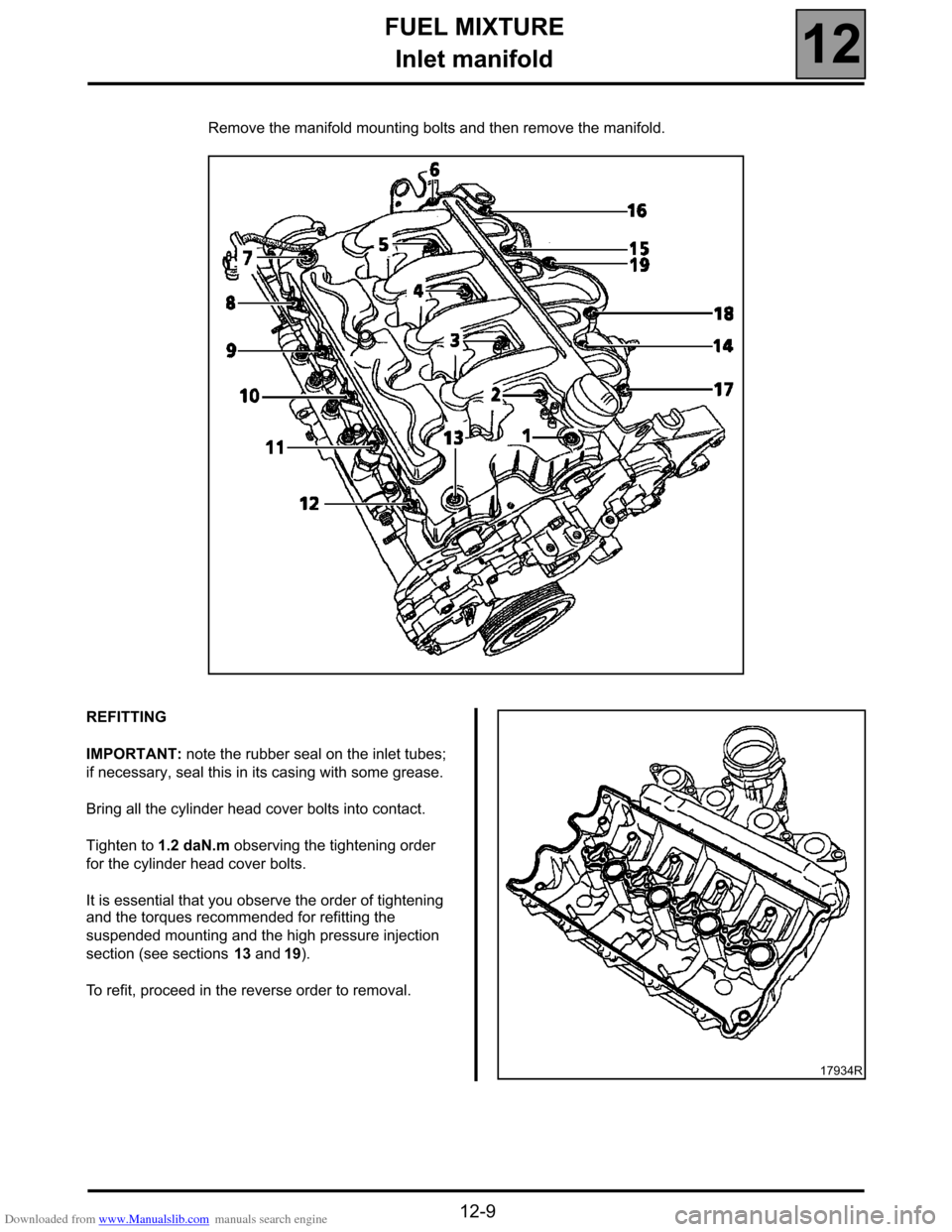
Downloaded from www.Manualslib.com manuals search engine FUEL MIXTURE
Inlet manifold
12
12-9
Remove the manifold mounting bolts and then remove the manifold.
REFITTING
IMPORTANT: note the rubber seal on the inlet tubes;
if necessary, seal this in its casing with some grease.
Bring all the cylinder head cover bolts into contact.
Tighten to 1.2 daN.m observing the tightening order
for the cylinder head cover bolts.
It is essential that you observe the order of tightening
and the torques recommended for refitting the
suspended mounting and the high pressure injection
section (see sections 13 and 19).
To refit, proceed in the reverse order to removal.
17934R
Page 34 of 52
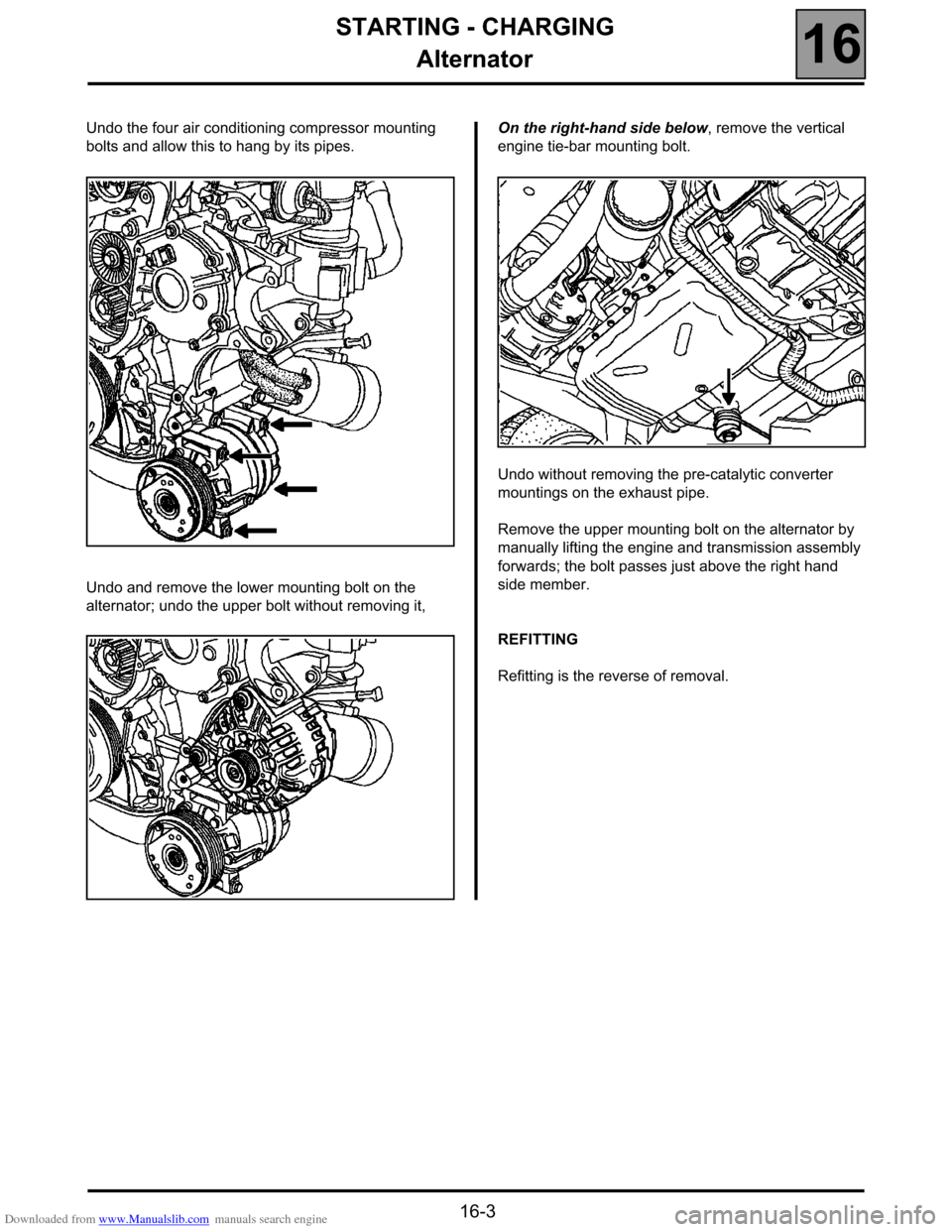
Downloaded from www.Manualslib.com manuals search engine STARTING - CHARGING
Alternator
16
16-3
Undo the four air conditioning compressor mounting
bolts and allow this to hang by its pipes.
Undo and remove the lower mounting bolt on the
alternator; undo the upper bolt without removing it,On the right-hand side below, remove the vertical
engine tie-bar mounting bolt.
Undo without removing the pre-catalytic converter
mountings on the exhaust pipe.
Remove the upper mounting bolt on the alternator by
manually lifting the engine and transmission assembly
forwards; the bolt passes just above the right hand
side member.
REFITTING
Refitting is the reverse of removal.
Page 36 of 52
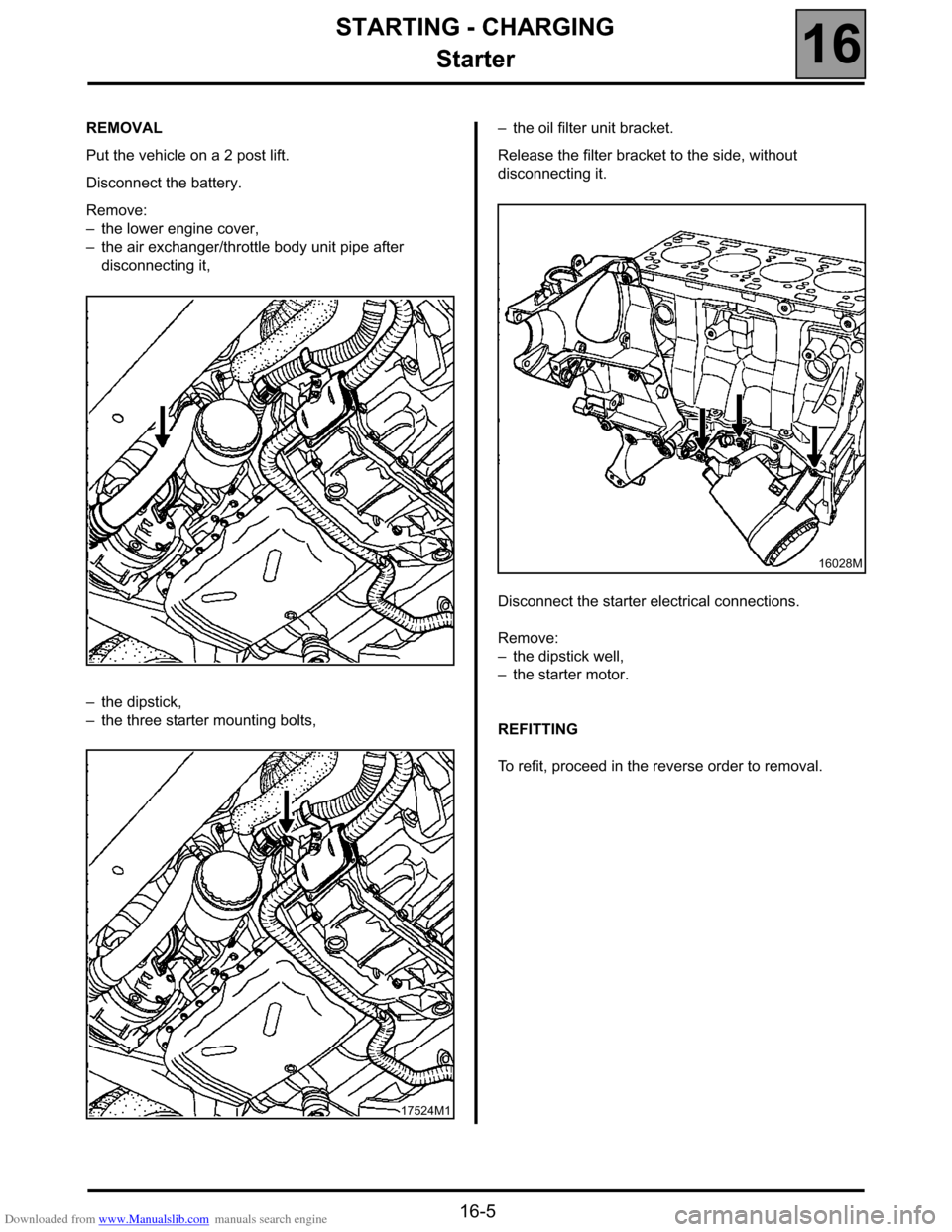
Downloaded from www.Manualslib.com manuals search engine STARTING - CHARGING
Starter
16
16-5
REMOVAL
Put the vehicle on a 2 post lift.
Disconnect the battery.
Remove:
–the lower engine cover,
–the air exchanger/throttle body unit pipe after
disconnecting it,
–the dipstick,
–the three starter mounting bolts,–the oil filter unit bracket.
Release the filter bracket to the side, without
disconnecting it.
Disconnect the starter electrical connections.
Remove:
–the dipstick well,
–the starter motor.
REFITTING
To refit, proceed in the reverse order to removal.
17524M1
16028M
Page 38 of 52
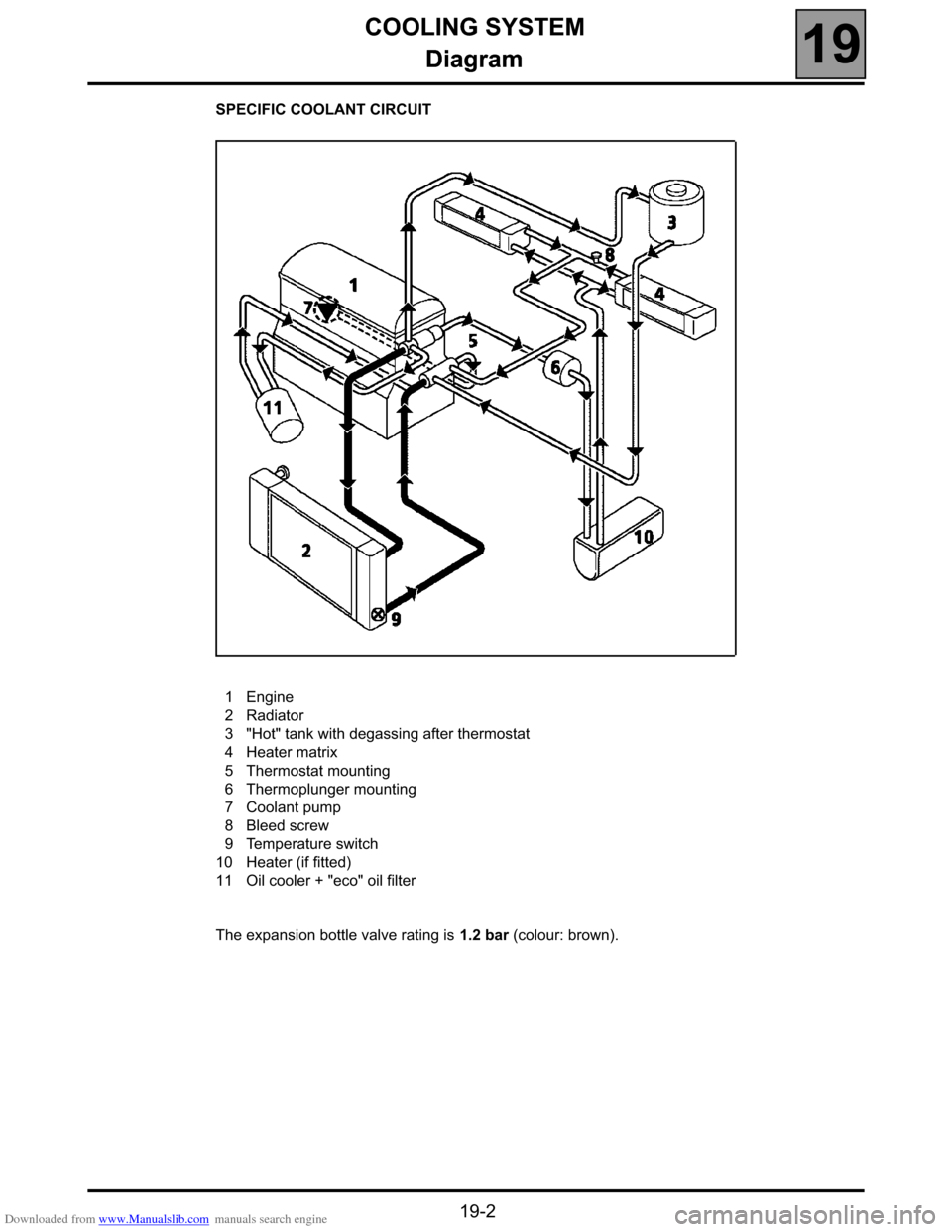
Downloaded from www.Manualslib.com manuals search engine COOLING SYSTEM
Diagram
19
19-2
Diagram
SPECIFIC COOLANT CIRCUIT
1Engine
2Radiator
3"Hot" tank with degassing after thermostat
4Heater matrix
5Thermostat mounting
6Thermoplunger mounting
7Coolant pump
8Bleed screw
9Temperature switch
10 Heater (if fitted)
11 Oil cooler + "eco" oil filter
The expansion bottle valve rating is 1.2 bar (colour: brown).